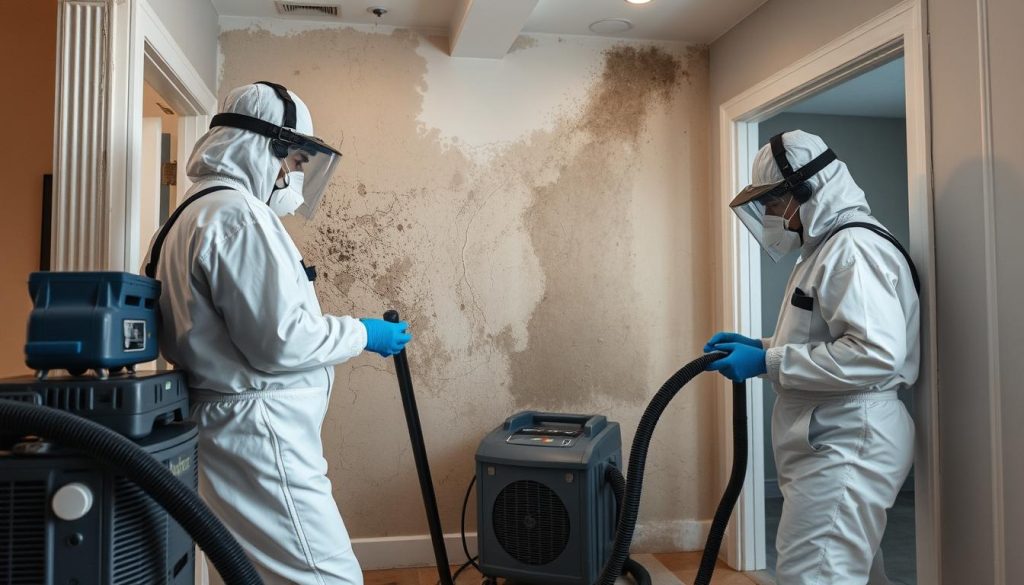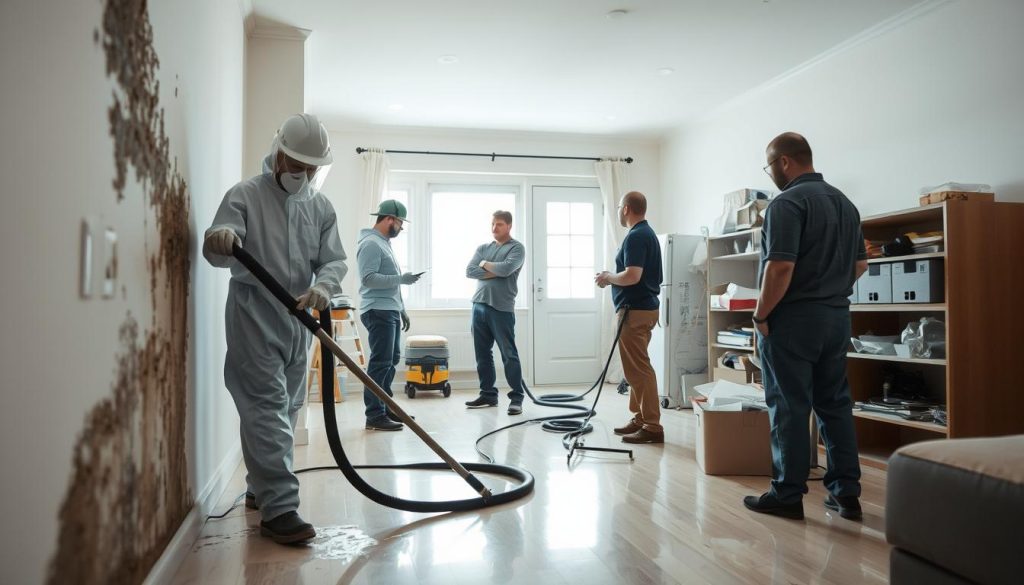If your home shows musty odors, visible spots, or water damage, you need clear guidance now. Professional remediation is a structured cleanup and repair effort that removes contaminated materials, halts moisture sources, and restores safe indoor air. You will learn why DIY fixes often worsen the problem and why trained teams use containment, HEPA filtration, and compliant disposal to protect your family and property.
The typical timeline runs from one to five days, depending on severity, location, and building materials. The full process covers inspection, source control, isolation, removal of affected porous items, cleaning with approved agents, HEPA vacuuming, drying, and final checks to confirm safety.
Expect practical examples, realistic timelines, and clear reasons to hire a certified company rather than guessing. For trusted local services and certified crews, see professional remediation services.
Key Takeaways
- You will learn the step-by-step process from inspection through final verification.
- DIY attempts can spread spores and hide the root moisture issue.
- Certified teams use containment, HEPA filtration, and safe disposal.
- Timelines usually range from 1 to 5 days based on extent and materials.
- Proper work protects health, indoor air, and long-term property value.
Introduction
When humidity or leaks persist, tiny spores can turn into a costly household problem that impacts indoor air and your health.
Act quickly: exposure may trigger allergy-like symptoms, asthma flare-ups, and in rare cases fungal infections or toxicity. The risk rises when water-damaged materials stay wet and allow colonies to grow inside walls, insulation, or flooring.

Professional services follow tested steps: isolate the area, stop the moisture source, remove contaminated materials, clean non-porous surfaces with approved agents, HEPA vacuum, then dry and replace finishes. This sequence protects your property and restores air quality while limiting cross-contamination.
- Identify and stop water at the source.
- Contain, remove, clean, and dry affected areas.
- Verify clearance so you can return safely.
Don’t rely on DIY patchwork. Incomplete cleanups often spread particles and prolong damage. Hiring specialists saves time—usually just a few days—and prevents repeated treatments and higher repair costs later.
Key Takeaways
Addressing both visible spots and the root moisture keeps indoor air safer and repairs lasting.

Choose full remediation over single-step removal. A full plan combines containment, removal of contaminated porous materials, disinfecting, HEPA vacuuming of hard surfaces, drying, and final checks. This sequence protects your family and prevents repeat growth.
Professional inspection reveals hidden pockets and guides safe containment. Teams then control humidity and run drying systems so restoration lasts. Typical work often finishes in one to five days, depending on scope and access.
- A complete remediation process fixes visible contamination and the moisture source so the issue does not return.
- Containment and filtration protect indoor air quality during work and prevent cross-contamination.
- Drying plus documented restoration restores function and appearance while reducing health risks.
- Skip DIY shortcuts; they can spread spores, miss hidden moisture, and lead to repeated removal efforts.
If you notice odors or stains, schedule an inspection to confirm scope and start proper containment and restoration steps.
AI Overview
Smart tools do more than speed work—they make your inspection clearer and the overall process more accountable.
How modern tools assist inspection, moisture tracking, and documentation
Smart sensors and image analysis map moisture behind walls and floors. This reveals pockets you cannot see. Tracking trends helps teams focus on hotspots and limit repairs.
Digital logs collect photos, readings, and notes in one place. That makes the job transparent from inspection through completion. Particle and environmental monitors also show when air returns to safe levels after containment and HEPA filtration.
Why human expertise, containment, and compliance still lead the remediation process
Technology guides decisions, but experienced technicians interpret data, set up isolation, and pick safe removal methods. Human judgment decides when materials must be discarded or can be cleaned.
Professional mold services combine tech with field protocols to control risk, prevent cross-contamination, and meet disposal rules. The result for you is faster work, clearer verification, and better quality outcomes.
- Precise moisture mapping uncovers hidden damage.
- Digital documentation makes results verifiable.
- Trained crews handle containment, safety, and legal disposal.
What is a mold remediation
Think of this as a full-system fix that removes colonies, stops water entry, and restores safe indoor conditions.

Mold removal vs. comprehensive care
Spot removal only tackles visible patches. That leaves hidden moisture and porous materials behind, so growth often returns.
Scope of work from inspection to prevention
Professionals start with inspection and repair of the moisture source. They set containment, spray affected zones, and remove contaminated drywall, carpet, or insulation.
- Treat non-porous surfaces with approved cleaners and HEPA vacuuming.
- Use drying equipment and dehumidifiers to restore safe humidity.
- Replace damaged components and add prevention measures like better ventilation.
Typical timelines and factors that affect time
Most projects finish within one to five days. Duration depends on extent, material types, hidden cavities, and access.
DIY risks: incomplete containment and missed moisture often mean repeat work and higher costs. Hiring pros saves time and reduces future problems.
When You Need Professional Mold Remediation
Persistent odors, warped trim, or rusty fittings often signal hidden damage that needs professional attention. If you notice staining or fuzzy patches after a leak, bring in a qualified team to define scope and stop ongoing water damage.

Clear warning signs
If you smell a musty scent, see visible growth, or family members feel unwell, those are red flags. Warped baseboards or rusted hardware point to hidden moisture that fuels recurring growth.
High-risk scenarios
HVAC involvement or recurring damp areas raise the stakes. Ducts can spread spores across multiple rooms, and contamination inside wall cavities often needs advanced containment.
Protect property and air quality
- Prevent spread: improper handling can aerosolize spores and move them to clean areas.
- Containment matters: professional teams seal zones, run negative pressure, and use HEPA tools.
- Save your property: early professional services limit structural damage and reduce repair costs.
Why DIY often fails
DIY attempts can disturb colonies, push contamination deeper, or drive particles into vents. Calling a trusted company early protects your indoor air and lowers long-term costs.
The Mold Remediation Process
Begin with a focused inspection to find where moisture keeps returning and fix that entry point first. That single step prevents re-growth and guides the rest of the work.
Identify and eliminate moisture
Technicians trace leaks, condensation, and humid zones. Repairing plumbing, roofing, or drainage stops conditions that feed colonies.
Isolation and containment
Crews set sealed barriers and negative pressure so spores do not spread to clean rooms. Containment protects your air during the work.
Safe removal of porous materials
Contaminated drywall, carpet, and insulation are removed, double-bagged, and transported out of the home. This step reduces hidden reservoirs of spores.
Cleaning protocols for non-porous areas
Teams apply approved biocides, scrub surfaces, then HEPA vacuum to capture fine particles. These cleaning steps make the space safe before repairs.
Drying, repair, and verification
Industrial fans and dehumidifiers restore safe humidity. Damaged materials are replaced and finishes restored so your space is functional again.
Final checks include air sampling and visual inspections. Documented clearance and compliant disposal protect you from future liability.
- Find and fix the moisture source.
- Contain the work area and remove contaminated materials.
- Clean, dry, restore, and verify air quality.
Don’t DIY: improper handling can spread spores, miss hidden moisture, and lead to repeated work. Trained teams follow the full remediation process and proper disposal rules so you get a lasting result.
Health, Air Quality, and Risk Assessment
Health effects can show quickly and may guide how fast you need to act.
Common symptoms and serious health considerations
You may notice nasal congestion, sore throat, coughing, wheezing, or irritated eyes and skin when contamination affects your home.
For some people these signs stay mild. For others they can become serious health events that require medical attention.
Vulnerable groups and long-term exposure concerns
Those with asthma, allergies, young children, older adults, or weakened immune systems react faster and more severely.
Long-term exposure can worsen chronic respiratory problems and lower overall quality of life.
Air quality improvements: HEPA filtration and clearance confidence
Professional teams use HEPA filtration to cut airborne particles during work and run clearance checks afterward to verify safe indoor air.
Documented air checks give you evidence that indoor air quality meets standards before you return to normal use.
Risk assessment: extent, type, moisture source, and structural impact
A full risk assessment examines the size and spread of contamination, including hidden zones behind walls or under floors.
Technicians note the type of growth, identify leaks or humidity sources, and evaluate structural damage to decide whether removal or cleaning best protects your health and budget.
- Symptoms: congestion, coughing, irritated eyes or skin.
- Vulnerable groups: asthma, allergy, immune-compromised individuals.
- Assessment: extent, type, moisture source, structural impact, and inspection documentation.
When the assessment finishes, you receive a clear plan that prioritizes health protections and restores safe air quality for your home.
Call to Action: Get Trusted Mold Remediation Services Today
A coordinated company can contain contamination, remove compromised materials, and return your home to use quickly.
Don’t risk spreading spores or exposing your family with DIY fixes. Professional remediation services protect health, stabilize your home, and cut long-term repair costs by addressing moisture and contamination together.
PrimeRestore Mold & Water, 2450 Riverside Dr, Suite 300, Chicago, IL 60606. Call (312) 555-0174.
- Don’t risk spread: bring in a coordinated team that contains, removes, sanitizes, dries, and restores.
- One accountable company: manages the full sequence and delivers verifiable results to protect your property.
- Priority scheduling and clear estimates: documented steps give a predictable timeline and minimal disruption at home.
- Proven containment and filtration: keep clean rooms safe while work proceeds behind sealed barriers.
- End-to-end restoration: moisture correction, removal of compromised components, and repair so spaces are use-ready at completion.
If you’ve noticed musty odors, stains, or recent leaks, act now to remove mold risks before damage expands. Ask about full restoration, detailed documentation, drying targets, and prevention recommendations so your property stays protected long term.
Conclusion
Finish strong: correct moisture, contain the area, and follow a licensed company’s plan to protect your home.
Effective remediation blends inspection, targeted removal of affected materials, biocide cleaning, HEPA vacuuming, controlled drying, and documented restoration. Most projects finish in 1–5 days depending on type and scope.
Quick FAQ: How long? Often one to five days. Can you stay in place? Your company will advise based on area and extent. Hidden growth behind walls is handled with targeted removal and drying; only severely damaged drywall or insulation is discarded.
To avoid repeat problems, schedule a professional inspection, get a clear scope, and let trained crews manage containment, cleaning, and final air checks. Acting now limits mold damage, protects your property, and restores safe air with minimal disruption.


